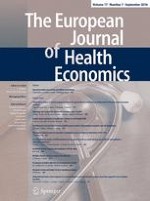Published in:

01-09-2016 | Original Paper
Comparative analysis of decision maker preferences for equity/efficiency attributes in reimbursement decisions in three European countries
Authors:
Petra Baji, Manuel García-Goñi, László Gulácsi, Emmanouil Mentzakis, Francesco Paolucci
Published in:
The European Journal of Health Economics
|
Issue 7/2016
Login to get access
Abstract
Background
In addition to cost-effectiveness, national guidelines often include other factors in reimbursement decisions. However, weights attached to these are rarely quantified, thus decisions can depend strongly on decision-maker preferences.
Objective
To explore the preferences of policymakers and healthcare professionals involved in the decision-making process for different efficiency and equity attributes of interventions and to analyse cross-country differences.
Method
Discrete choice experiments (DCEs) were carried out in Austria, Hungary, and Norway with policymakers and other professionals working in the health industry (N = 153 respondents). Interventions were described in terms of different efficiency and equity attributes (severity of disease, target age of the population and willingness to subsidise others, potential number of beneficiaries, individual health benefit, and cost-effectiveness). Parameter estimates from the DCE were used to calculate the probability of choosing a healthcare intervention with different characteristics, and to rank different equity and efficiency attributes according to their importance.
Results
In all three countries, cost-effectiveness, individual health benefit and severity of the disease were significant and equally important determinants of decisions. All countries show preferences for interventions targeting young and middle aged populations compared to those targeting populations over 60. However, decision-makers in Austria and Hungary show preferences more oriented to efficiency than equity, while those in Norway show equal preferences for equity and efficiency attributes.
Conclusion
We find that factors other than cost-effectiveness seem to play an equally important role in decision-making. We also find evidence of cross-country differences in the weight of efficiency and equity attributes.





